The quick commerce sector is experiencing a remarkable surge, currently valued at $3.5 billion and projected to skyrocket to nearly $9 billion by 2028, with a compound annual growth rate (CAGR) exceeding 40% over the next four to five years. This rapid growth can be attributed to an increase in shopping frequency and shorter delivery times, enabling consumers to make purchases more often. Typically, loyal customers engage in 10-12 shopping trips each month, primarily focusing on groceries, though categories like beauty and personal care, household items, and kitchen appliances are also gaining popularity.
Unique Consumer Behavior in Quick Commerce
Unlike traditional e-commerce platforms such as Amazon and Flipkart, quick commerce shoppers tend to have a more focused approach. Research indicates that 40% of searches on quick commerce platforms are direct product queries, while only 60% involve browsing through categories. This trend highlights a preference for targeted purchases. For instance, the search volume for specific products like Lay’s chips surpasses searches for broader categories like "chips."
Elara Capital emphasizes the importance of understanding consumer behavior at a micro level, particularly within dark stores. “To optimize throughput and minimize payback periods, it is vital to align product assortments with competitive pricing,” the report suggests. Such data-driven insights can significantly influence the success of quick commerce outlets operating in the same vicinity.
Advertising Revenue: A New Frontier
Advertising revenue is emerging as a crucial growth engine for quick commerce platforms, outperforming traditional retail channels that rely solely on trade commissions. According to insights from Elara Capital, the annual recurring revenue (ARR) from ads for three major quick commerce platforms has reached ₹30-35 billion, which is about half of Amazon India’s projected ad revenue of ₹67 billion for FY24.
- Blinkit: 45% of the ad revenue
- Zepto: 35%
- Instamart: 20%
This growth is remarkable, especially considering that only 8% of online commerce users (approximately 18 million in 2023) engage in quick commerce, amidst a broader online shopping base of 230 million. Key factors contributing to this trend include:
- Higher shopping frequency on quick commerce platforms.
- Brand onboarding policies that require minimum advertising spending, particularly beneficial for lesser-known brands.
- Two-way advertising opportunities, including promotional placements during the 10-20 minutes post-order delivery tracking period.
Interestingly, smaller brands are reported to be more aggressive in their advertising strategies on quick commerce platforms compared to their larger counterparts.
Growing Interest from Brands
The allure of quick commerce is prompting a wave of brand onboarding, as the rapid inventory turnover associated with swift delivery options is appealing to businesses. However, due to physical space limitations—quick commerce stores typically around 3,500 sqft compared to 40,000 sqft for modern trade—these platforms are selective in which brands they accept. Despite this, the number of onboarded brands is expected to expand alongside the development of larger dark store formats.
Balancing a diverse range of products, from well-known FMCG brands to emerging new-age companies, is essential for quick commerce platforms. Notably, quick commerce is driving significant sales in specific categories, accounting for 60-70% of the online retail market for soft drinks, as highlighted by Elara Capital.
Non-Metro Markets: A Complex Landscape
According to Elara’s findings, the performance of quick commerce in non-metro areas is unpredictable, influenced by various factors like unit economics and product assortment. Traditional retail channels, including Kirana stores, are expected to maintain relevance in these regions for the foreseeable future. Key reasons for this include:
- Consumers’ reliance on Kirana shops due to flexible credit options, particularly in Tier II and III cities.
- A lower density of working professionals per household compared to metropolitan areas.
- Demand for low-cost sachet products, which may not align with quick commerce’s typical order values.
The report also notes that modern trade entities like DMart may not experience significant impacts in Tier II and III cities, where price sensitivity is a major concern for consumers.
The Dominance of FMCG and the Rise of Kirana Delivery Services
In the quick commerce landscape, FMCG items currently represent 80% of sales, and over 90% in smaller urban centers. Meanwhile, quick commerce platforms are increasingly diversifying their product offerings to enhance average order values. However, larger Kirana stores are stepping up their home delivery services, presenting new challenges for quick commerce in these locales.
To summarize, the competitive hierarchy in terms of profit margins is as follows: Kirana > Modern Trade > Quick Commerce. As quick commerce continues to evolve, understanding these dynamics will be crucial for all stakeholders involved.











